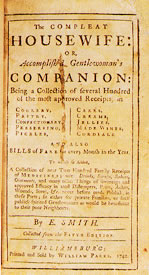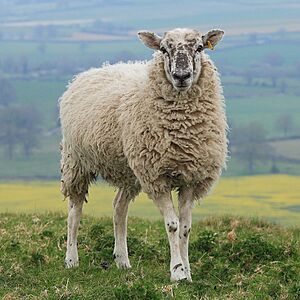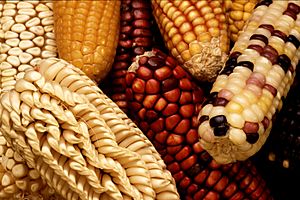Cuisine of the Thirteen Colonies facts for kids
The cuisine of the Thirteen Colonies describes the foods, eating habits, and cooking styles of the early American colonies before 1776. Before the American Revolution, colonists relied on food imports from Britain and the Caribbean. But as tensions grew, they started growing more of their own food to become self-sufficient. This led to big changes in what Americans ate.
Contents
Food Across the Colonies
Virginia's Cooking Style
In the early 1600s, English settlers arrived in North America, mostly around Chesapeake Bay in Virginia and Maryland. Food was much more plentiful in the American South than in England. Everyone, rich and poor, ate a lot of meat every day.
Cooking in Virginia often involved frying, simmering, and roasting, similar to southern England. Wealthy families used many cooking methods. Poorer families usually just boiled or fried their food. Baking was not very common at first.
Rich families might eat dishes like fricassees, which are meats cooked in a sauce with herbs and sometimes wine. Poorer families often ate corn porridge or mush. They also ate hominy with greens and salt-cured meat. Later, traditional southern fried chicken and chitlins became popular.
New England's Dishes
New England had lots of wildlife and seafood. Settlers here preferred traditional English foods, even if they had to use new ingredients from America.
Baked beans and pease porridge were common daily meals, especially in winter. They were usually eaten with a dark, coarse bread. This bread was first made with wheat and corn. But after a plant disease in the 1660s, it was made with rye and corn, becoming known as "rye an injun."
A popular dish was vegetables and meat boiled together. Unlike other regions, they cooked these foods together and often without much seasoning.
Baking was a favorite way to cook. New England is where many classic American dishes began, like apple pie and baked Thanksgiving turkey.
Delaware Valley and Mid-Atlantic Food
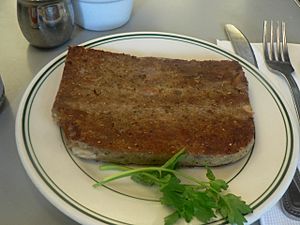
The Quakers came to the New World from England in the 1600s. They settled mainly in the Delaware Valley. Quakers lived very simply. They believed in plain food and discouraged eating or drinking too much.
William Penn, who founded Pennsylvania, encouraged his followers to be thrifty. He advised them to eat only until they were satisfied. Quakers found plenty of food in the New World, like game, berries, fish, and birds. But they still kept their simple eating habits.
Some Quakers avoided butter as a way to live simply. Some even avoided tea and meat. Their beliefs also led many to avoid products that were linked to unfair practices. For example, they might avoid butter because of war taxes, or coffee because it was produced by forced labor.
Quaker meals were more equal than those of other groups. Everyone in the household, including children and servants, ate at the same table.
The most common Quaker cooking method was boiling, which they brought from England. Boiled breakfasts and dinners were standard. They also made "pop-robbins," which were flour and egg batter balls boiled in milk. Boiled dumplings and puddings were so common that outsiders called them "Quaker food."
Travelers noted that apple dumplings were eaten almost daily in the Delaware Valley. Cookbooks from the area specialized in puddings and dumplings. Food was often preserved by boiling or simmering.
A popular type of dish was "cheese" or "butter." This was a general term for foods prepared by slow boiling or pressing. They could be made from apples (like apple butter), plums, or walnuts.
Cream cheese started with Quaker cooking. In colonial times, it wasn't true cheese. Instead, it was cream gently warmed and then wrapped in cloth until it became semi-solid.
Dried beef was very popular in the Delaware Valley. It was eaten with puddings and dumplings for extra flavor. It was so common that it was often called "Quaker gravy" in the 1700s.
German immigrants also influenced the region's food in the 1700s. Scrapple, a dish made from meat scraps and grain, became a main food for many generations.
Backcountry Meals
The last big wave of British immigrants came to the colonies between 1720 and 1775. About 250,000 people, mostly from the border areas of northern Britain (Scots-Irish or Scottish), came seeking a better life. Many were poor and used to hard times. They settled in what was called the "backcountry," on the frontier and in the highlands.
A typical breakfast might be toasted bread, cheese, and any leftover meat or vegetables from dinner. In summer, people drank fresh milk.
Backcountry diets relied heavily on mush made from soured milk or boiled grains. Clabber, a yogurt-like food made with soured milk, was a common breakfast for all ages. Other British groups did not share this eating habit.
Oatmeal mush was popular in Britain's borderlands and remained popular in America. The difference was that corn replaced oats, and it's still known today in the South as grits. Flat cakes of unleavened dough baked on bakestones or griddles were common. They were called "clapbread," "griddle cakes," or "pancakes."
Potatoes, originally from South America, became important in North America after northern British settlers brought them in the 1700s. They became a main food in the backcountry along with corn.
Pork was not a common food among northern Britons, who preferred sheep meat. In the American colonies, raising sheep was harder. So, pork replaced mutton as the main meat.
Eating "sallet" or "greens" stayed popular. But Old World vegetables were replaced with plants like squashes, gourds, beans, corn, land cress, and pokeweed.
The main cooking style in the British borderlands and American backcountry was boiling. Besides clabber, porridge, and mushes, common dishes included various stews, soups, and pot pies.
People ate from wooden or pewter plates called trenchers. They used two-tined forks, large spoons, and hunting knives. Breakable dishware was not popular.
Unlike the Quakers, backcountry settlers often had feasts with lots of food and drink whenever possible. Their cooking was seen as less refined than in the North or South. Some outsiders criticized backcountry cooking, describing it as very messy.
Backcountry people also didn't like coffee and tea much. They called them "slops" and thought they were only for sick people or those who couldn't work.
Diet Before the American Revolution
When colonists arrived in America, they planted familiar crops from Europe. They also raised animals like cattle and sheep for meat, leather, and wool, just as they had in Britain.
The colonists faced challenges with the new climate. But trade with Britain, Europe, and the West Indies helped them create a cuisine similar to British regional foods. Local plants and animals offered new food options. However, colonists often stuck to their old traditions. They used new foods in the same ways they used familiar European ones, or ignored them if old favorites were available.
The American colonial diet changed by region. By the mid-1700s, local food patterns were well-established.
Cookbooks brought to the New World show a clear preference for British cooking. There was a general dislike for French cooking. One common cookbook was The Art of Cookery Made Plain and Easy by Hannah Glasse.
The French and Indian War (1754-1764) increased anti-French feelings in the colonies. This conflict strengthened an old distrust of the French. It also led to the forced removal of the Acadians, who moved to places like Louisiana. The Acadian French brought a strong French influence to Louisiana's diet, but it didn't spread much beyond that region.
Colonial Crops
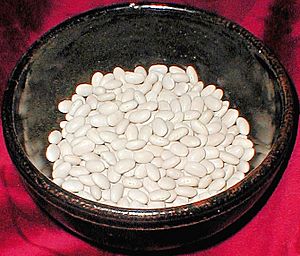
Many vegetables grew in the northern colonies. These included turnips, onions, cabbage, carrots, and parsnips, along with pulses and legumes. These vegetables stored well through the cold winter months. Other vegetables, like cucumbers, could be salted or pickled to preserve them.
Farming in the northern colonies followed the seasons. Fresh greens were only available in summer.
Besides vegetables, many seasonal fruits were grown. Fruits not eaten fresh were often preserved as jam, dried, or cooked into pies that could be frozen in winter.
Some New World vegetables, like beans, squashes, and corn, were quickly adopted by European colonists. Pumpkins and gourds grew well in the northern colonies. They were often used to feed animals, as well as for people to eat.
Animal Protein Sources
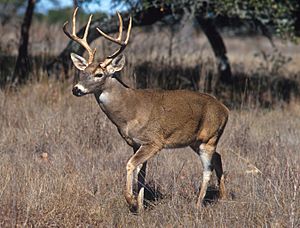
Hunting was a useful skill for colonists. Most northern colonists hunted themselves or bought game from others. Hunting was preferred over raising animals because domestic animals were expensive. Also, it took a lot of work to protect them from predators, Native Americans, or the French.
Common hunted game included deer, bear, buffalo, and turkey. Larger parts of the animals were roasted and served with sauces. Smaller parts went into soups, stews, sausages, pies, and pasties.
Venison (deer meat) was the most popular game. The plentiful meat was often preserved by potting or drying it into jerked meat. Venison was especially popular during the Thanksgiving season.
Buffalo was an important protein source until about 1770. By then, too many had been hunted in British America. Bears were common in the northern colonies, especially in New York. Many thought bear leg meat was a special treat. Bear meat was often dried to preserve it.
Besides game, mutton (sheep meat) was eaten sometimes. Keeping sheep provided wool for the household. When a sheep was too old for wool, it could be used for meat.
Sheep were first brought to the Americas by the Spanish in Florida. In the north, the Dutch and English also brought different kinds of sheep. English farmers often let their sheep roam freely, eating various plants. This kind of diet made the meat strong and tough, so it needed aging and slow cooking to become tender.
Animal fats and oils were used to cook many colonial foods. Rendered pork fat, especially from bacon, was the most popular cooking fat. Pork fat was used more in the southern colonies because the Spanish introduced pigs there earlier.
Many homes kept a deerskin sack filled with bear oil for cooking. Solidified bear fat looked like shortening. Colonists also used butter for cooking. But it was rare before the American Revolution because cattle were not yet plentiful.
Colonists near the New England coast often ate fish, crustaceans, and other sea animals. They ate a lot of turtle, which was a delicacy also sent to Europe. Cod was eaten fresh and salted. Salted cod could be stored for a long time. Lobsters were plentiful in the waters and common in the New England diet. Some people even complained about eating lobster and codfish too often. They were sometimes used as pig food.
The best quality cod was usually dried and salted. It was then sent to the Mediterranean in exchange for fruits not grown in the American colonies.
Northern Colonies' Diet
A key feature of the New England diet was how food availability changed with the seasons. While farming in the southern colonies happened most of the year, northern growing seasons were shorter. This limited fresh fruit and vegetable availability.
However, coastal colonists had plenty of fresh fish year-round, especially in the north.
Wheat, the main grain for English bread, was almost impossible to grow in the North. Importing wheat was expensive. Substitutes included corn in the form of cornmeal. The johnnycake was generally seen as a simple substitute for wheat bread, but people in both northern and southern colonies accepted it.
Southern Colonies' Diet
Unlike the North, the South didn't have one main cultural origin or cooking tradition. The southern colonies also grew a wider variety of farm products.
Enslaved people and poor Europeans in the South ate similar diets. Their food was based on many native New World crops. Poor rural people often hunted and ate squirrel, opossum, rabbit, and other woodland animals. Salted or smoked pork often added protein to their vegetable diet.
People on the "rice coast" ate a lot of rice. The southern poor and enslaved people used cornmeal for breads and porridges. Wheat was not an option for most poorer residents in the southern colonies.
Well into the 1700s, the Chesapeake region still relied on homemade cider as a main drink. In most small farms, women made the cider using local products. This production was seasonal, as only large farms had the money and tools to make alcohol all year.
The southern colonies can be divided into uplands and lowlands culturally. This difference is seen in their diet and food preparation.
The uplands diet often included cabbage, string beans, and white potatoes. Most wealthy white people in the uplands avoided crops from Africa. This was because these crops were associated with enslaved black people.
Those who could grow or afford wheat often had biscuits for breakfast, along with large portions of pork. Salted pork was a staple of any meal. It was used to flavor vegetables and eaten directly as protein.
The coastal lowlands had a more varied diet, especially around Charleston and New Orleans. This area also included much of the Acadian French regions of Louisiana. This diet was heavily influenced by Africans, Caribbeans, and the French. Rice played a big part in the diet.
Also, unlike the uplands, the lowlands' protein came mostly from coastal seafood and game meats. Many dishes used peppers, as they still do today.
While American colonists generally disliked French food and many native foods, the French appreciated native ingredients and dishes.
Dietary Changes Due to Boycotts
The colonists depended on Great Britain for food and other basic products. When Britain increased taxes and tariffs on goods, colonists were expected to keep buying English and West Indian products.
As a result, many colonists started to boycott imported goods. They chose to use products made in America instead. This boycott wasn't widespread at first, but growing support for it helped lead to the revolution against Britain.
As the British Parliament passed more laws, changes in what American colonists bought and traded eventually altered their diet. Starting with the Molasses Act of 1733, followed by the Sugar Act of 1760, people started drinking different types of alcohol.
This was more than just a protest against taxes on molasses, which was used to make rum. Whiskey became the drink of choice for many American colonists who wanted to show their defiance to Britain. In the northern colonies, whiskey was made with rye. The southern colonies preferred corn whiskey. Rye was seen as a more refined grain. Corn whiskey was presented as more patriotic because it was made from a native American crop.
Whiskey production wasn't common in the early colonies. Upper-class colonial society looked down on American whiskey until the American Revolution. Some even saw it as a symbol of bad behavior.
However, Scottish, Irish, and German immigrants brought a taste for strong spirits from their homelands in the 1730s. These groups continued to make strong spirits using imported stills. They did this to protest the unpopular economic controls introduced by Parliament.
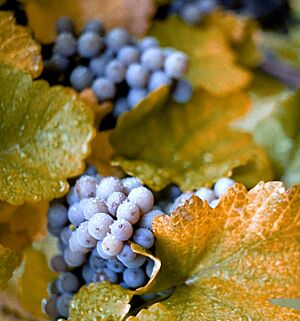
The Revenue Act of 1764 heavily taxed Madeira and other wines. This led to another boycott, this time against imported wines. This promoted another native American crop: the Vitis labrusca grape. In 1765, Benjamin Franklin used Poor Richard's Almanack to encourage growing American grapes to make domestic wines.
One of Franklin's friends, Benjamin Gale, said, "We must drink wine of our own making or none at all." This idea was common in the colonies from 1764 until the Revolution. Many who supported drinking less alcohol also supported American wine production at this time. For them, drinking only wine or beer was a form of moderation, instead of stronger spirits.
The Quartering Act of 1765, more than anything else, reduced colonists' money. This made it harder to buy imported luxury goods. The Stamp Act of 1765 led many merchants to boycott imported goods. This was further strengthened by the Townshend Act of 1767.
However, these boycotts were short-lived. Once the Townshend Act was removed, colonists quickly went back to buying non-essential goods.
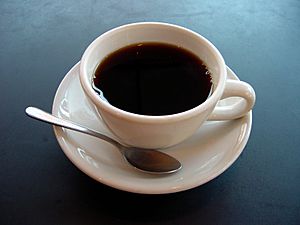
The Tea Act of 1773 became a big issue for the colonists. The famous Boston Tea Party was a direct protest against this act. But a more important change happened in the colonists' choice of drink. In 1773, John Adams wrote to his wife, Abigail, saying, "Tea must be universally renounced and I must be weaned, and the sooner the better."
This began the American shift from tea to coffee. In a strong boycott, the housewives of Falmouth, Massachusetts publicly promised to serve only coffee in their homes. This inspired other households across the colonies to do the same.
Effects of the American Revolution
In 1775, the Continental Congress decided that no imports would enter the American colonies. Also, no exports would go from America to Britain. Some historians believe this greatly affected American farming. Others say it had little effect because the local market was strong enough. The debate exists because the American economy was very diverse, there was no standard money, and records were not always kept well.
By the start of the American Revolution, with George Washington as its military leader, changes in the American diet had already happened. Coffee quickly became the usual hot drink in the colonies.

As the American colonies went to war, they needed many soldiers and supplies. Soldiers needed uniforms. Since all shipping into the colonies had stopped, wool became very important for the war effort. During the Revolution, eating mutton almost completely stopped in many areas. In Virginia, it became illegal to eat mutton except in extreme emergencies.
Game animals had started to become scarce east of the Mississippi River. This might have been due to too much hunting, or the animals might have moved west as the colonial population grew. Luckily, Irish and Scottish immigrants had been bringing cattle to the American colonies since the early 1700s. So, when game became scarce and mutton was restricted, cattle were available as a source of protein.
This change increased farmers' profits from raising animals. Small-scale cattle-raising began during the French and Indian War. But when the American Revolution came, farmers could increase their cattle herds. This also increased the amount of beef in the American diet. Besides beef, cattle also increased the production of milk and dairy products like butter. This might have led to a preference for butter over pork fat, especially in the northern colonies.
With British soldiers arriving to stop the revolution, and naval battles happening at sea, areas used for saltwater fishing became unsafe. So, fishing stopped for much of the war. Also, many fishing boats were turned into warships.
Before the war, people often talked about the huge numbers of lobsters and cod off the New England shores. This seemed to change during and after the war. This was likely due to the many ships and cannons in the ocean waters. Once lobster and cod fishing restarted, most fishermen found that the lobsters and cod had moved away from the shores.
Americans had historically disliked French cooking. But that opinion, at least a little, began to change with the American alliance with the French.
In the first American edition of Hannah Glasse's Art of Cookery Made Easy, insults aimed at French dishes disappeared. Some Bostonians even tried to cook French food for their French allies. Sometimes this had funny results, like putting whole frogs into soups instead of just their legs. Still, the alliance supported a friendship with France. This later led to many French cooks and chefs moving to America during the French Revolution.
The American diet changed because of this friendship. It also changed due to the boycotts and conflicts with Britain. After some time, trade with the West Indies resumed but was limited to necessary items. Goods that helped the war effort in America were traded. For example, crops like rice from the Carolinas were shipped out, and coffee beans were imported to brew America's new favorite drink.
Images for kids
-
Hops, a necessary ingredient to make beer, were not imported during the American Revolution, leading to a decline in beer production.
See also
 In Spanish: Gastronomía de las Trece Colonias para niños
In Spanish: Gastronomía de las Trece Colonias para niños


